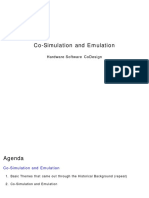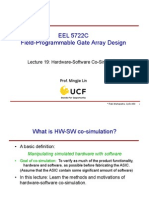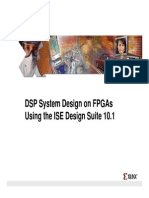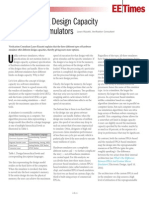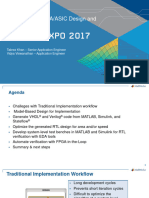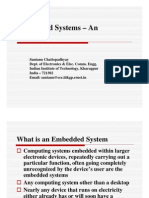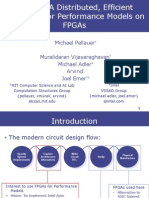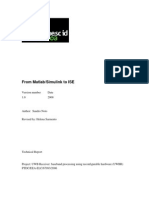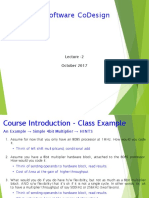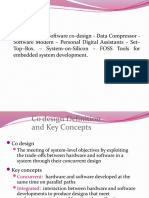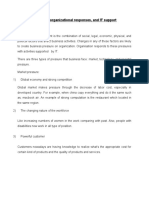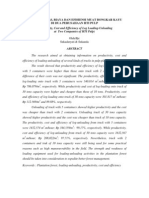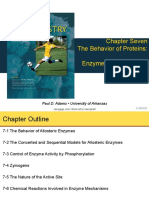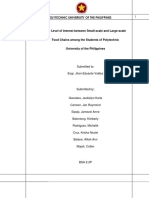Co-Simulation and Emulation
Hardware Software CoDesign
October 2011
�Agenda
Co-Simulation and Emulation
1. Basic Themes that came out through the Historical Background (repeat)
2. Co-Simulation and Emulation
3. Continue on ”Answering Machine” Assignment Discussions. Give clear milestones.
4. Taking Stock
1
�Co-Simulation and Emulation
Basic Themes
1. Modeling :: Because parallelism is important, the choice of an appropriate modeling
paradigm is also important. Different modeling formalisms need to be developed that
capture the various aspects of system behavior.
2. Analysis and Estimation :: Different models of the same system behavior need to
be analyzed and estimated for performance. Performance would include tradeoffs for
Area, Speed, Power. Cost to build, Time to Market are other factors.
3. System-level partitioning, synthesis and interfacing :: The basic steps of co-
synthesis. A range of methodologies are applied for this.
4. Implementation generation :: Once the architecture has been generated and trade-
offs known, the designs for the hardware and software components must be created.
5. Co-simulation and Emulation :: This helps designers to evaluate architectures and
validate assumptions on implementations. Emulation uses FPGA / other emulation
techniques to further speed up execution of system models.
2
�Co-Simulation and Emulation
Screen Shot of CoSimulation System
3
�Co-Simulation and Emulation
Introduction
1. Hardware-software co-simulation is the combination of simulation of software running
on a processor hardware with the fixed-function hardware components / sub-systems.
2. From here on.. there can be various methods for co-simulation.
(a) Do a detailed processor simulation (full RTL) → too time consuming when simu-
lating large software programs, and too slow to bring existing components to work
with simulated components. Thus there is a requirement for a set of models for
existing components (called test-bench). The creation, maintenance and usage
of testbench adds to the cost of the device which is being designed.
(b) For simulating larger software programs, abstract processor models are used. (us-
age of behavioral models for processors).
• Bus Functional Model (BFM) :: abstracts from program execution and describes
the processor bus interface function and timing only (think of a donut).
• Cycle-accurate Model :: executes the program instructions with the accurate
number of processor clock cycles, but without detailed interface timing. Such
a model allows the designer to analyze the system timing and to validate the
cooperation of hardware components and processors.
• Instruction Set Simulator Model :: executes the program instructions preserving
the program function but completly abstracts from timing. Main applications
are program validation and debugging the software program.
4
�3. Cycle-accurate and Instruction Set simulator are well suited to compiled mode (say
nc)simulation.
4. Abstract Models are simpler, faster to execute, and can be used in early phases of a
design where implementation details are still open.
5. Co-simulation uses abstract models to form a virtual prototype, co-emulation provides
a real prototype by function implementation in hardware. This prototype can be used
to accelerate co-simulation, but it can also be installed in the real environment like a
hardware in the loop to investigate the system function under real conditions.
6. The holy grail for co-simulation and emulation :: Investigation of various possibilities
with different tradeoffs in hw/sw is only sensible if different hw partitions can be
implemented as fast as software can be compiled into machine code. High Level of
Synthesis, different abstraction models are therefore enablers for hw/sw co-design.
�Co-Simulation and Emulation
Emulation System
1. An Hardware Emulator would allow the full design to be imported onto the Emulator
(through a said flow) onto a board which has real components.
2. FPGAs, QuickTurn (Palladium) are different emulation system (system components)
which are used for prototyping.
3. Advantage of emulation are ::
• Higher speed, in cases it is just 100x slower than real time components.
• Allows for Higher Level of Hardware Verification or Application Level Verification.
• Allows for Development of Firmware.
• Allows for testing the design and the software before silicon. (With a speed of
500,000 cycles per second, it was possible to test the boot sequence of Solaris on
a UltraSparc Architecture)
• Simulation aims at the general reduction of the number of functional and tim-
ing errors, whereas emulation in general serves realistic loads in demonstrating
functional correctness.
5
�Co-Simulation and Emulation
Emulation System
1. Dis-Advantage of emulation are ::
• Timing errors in the actual device are hard to detect on emulation platforms (this
is possible in simulation system using sdf timing annotations).
• In case of FPGAs, a separate effort has to be done to meet timing requirements
for the FPGA itself.
• Cost is higher for emulation.
• Emulation is generally only used after thorough simulations so that there is low
expectation of design errors.
6
�Co-Simulation and Emulation
Methods in Deploying Emulation System
7
�Co-Simulation and Emulation
FPGA Based System
1. The Static RAMs based implementation provides unlimited programmability to FP-
GAs.
2. FPGAs use building blocks called CLB (configurable logic block),
3. Add Dedicated Memory Blocks,
4. Clocking Blocks,
5. With Interconnects to connect one CLB, Memories, Clocks, IO to each another, and
8
�6. An IO interface to talk to external (real) components.
7. GROUP DISCUSSION :: Discuss that a 4 input LUT can serve as a universal gate.
8. There can be architectures where the CLB itself can serve as a Memory Block.
�Co-Simulation and Emulation
FPGA Based System
1. GROUP DISCUSSION :: Discuss that a 4 input LUT can serve as a universal combo
gate.
9
�Co-Simulation and Emulation
FPGA Based System – CLB of a Xilinx FPGA
10
�Co-Simulation and Emulation
FPGA Based System – IO of a Xilinx FPGA
11
�Co-Simulation and Emulation
FPGA Based System
1. FPGAs also come with various capacity tags, which are suitable for different ranges
of devices being built till date.
2. There exists systems and software which use ”arrays” of FPGAs for larger SoC’s or
”chip-sets”
3. As FPGAs evolve through the technology nodes, capacity naturally increases and
increasingly FPGA vendors are able to integrate common CPUs (like ARM), common
blocks like DSP MAC units, Communication physical layer (Phy) like Serdes, Ethernet
Phy, USB Phy, differential IO’s.
4. Unlike Emulation systems, FPGAs are also being used for doing field trials i.e, in
an environment where the actual ASIC would be. Thus portability is also become a
requirement for prototyping.
12
�Co-Simulation and Emulation
Emulation Based System – Example of Palladium XP – From Cadence
Website
13
�Co-Simulation and Emulation
Emulation Based System – Example of Palladium XP – From Cadence
Website
1. Unparalleled operational efficiency and user flexibility with highly scalable systems
2. Delivers high performance of up to 4MHz
3. Allows flexible configurations from 4 million gates to 2 billion gates
4. Supports up to 512 users simultaneously
5. Advanced compiler and runtime capabilities
6. Integrates seamlessly with Incisive products
7. Offers a unified, advanced debug environment for HW/SW co-verification
8. Supports SCE-MI and SystemVerilog DPI for third-party models/tools integration
9. Unique platform extensions
10. Supports metric-driven verification acceleration
11. Supports industry-standard hardware design and verification languages and the Open
Verification Methodology
14
�12. Enables Dynamic Power Analysis and verification by integrating with the Encounter
RTL Compiler power estimation engine
13. SystemC-to-emulation flow allows users to integrate high-level abstraction models
into the system verification environment
14. Integrates with the comprehensive SpeedBridge family of rate adapters and the Ca-
dence Verification IP portfolio
�Co-Simulation and Emulation
Emulation Based System – Example of Palladium XP – From Cadence
Website
1. GROUP DISCUSSION :: Compare an Emulator Vs FPGA
15
�Co-Simulation and Emulation
Emulation Based System – From Palladium XP – Rapid FPGA Based Sys-
tem – From Cadence Website
16
�Continue on ”Answering Machine” Assignment Dis-
cussions
Marking Milestones
1. Take a break for 5mins.
2. Implementation Documentation – Hardware and Software components, with all IPś in
place, assumptions et. all → November 13 Deadline (10 marks)
3. Actual Implementation, documentation updates and enabling me to replay with my
own set of tests → December 30 Deadline (10 marks)
4. Selection of key persons from the team (groups)
(a) IP creation / reuse
(b) System Hardware Integration
(c) System Software Integration
(d) TestBench Creation and System Checkout → Hardware & Software
(e) Total Hardware / software → bringing it all together
17
�Continue on ”Answering Machine” Assignment Dis-
cussions
Requirements Till date
1. System C model of the system.
2. Use models for analog components.
3. Should have System C testbench as a part of SoC verification.
4. ReUse preferred to creation of already existing components.
Solution components / discussion
1. Decide Microprocessor.
2. How to write software program.
3. Memory requirements.
4. Model of ADC required (file input and digital output).
5. Input Buttons.
6. On/Off Button - special case.
7. Model of LEC (7 segment display).
8. Some real time clock – keep date and time (simplification is ok)
9. Each message has upper bound (10sec) – min 16 messages.
10. Announcement = single 10 seconds.
11. Announcement hear out through microphone (DAC)
12. Light keeps blinking if there is a new message.
18
�”Answering Machine” Assignment
Diagram of Use Case
19
�”Answering Machine” Assignment
Next Steps for Implementation document
1. Entity Definition
2. Processor / Dedicated Hardware decision
3. System State Machine or StateChart diagram (gross functionality)
4. Individual functionality State Macine or StateChart diagram
20
�”Answering Machine” Assignment
Next Steps for Implementation document – Entity Definition
21
�”Answering Machine” Assignment
Next Steps for Implementation document – Function Level State Charts – ON/OFF
22
�”Answering Machine” Assignment
Next Steps for Implementation document – Function Level State Charts
23
�”Answering Machine” Assignment
Next Steps for Implementation document – Function Level State Charts
24
��Taking Stock
1. Historical perspective – from microprocessor based designs to current SoCs.
2. A Multiplier example to illustrate the tradeoffs.
3. Typical HW/SW co-design flow.
4. 5-Basic Themes for hw/sw co-design.
5. Example of a TouchScreen System. Defining different parts of the system.
6. Modeling – Basic Modeling Requirements for co-design.
7. Modeling – Modeling using SystemC.
8. Analysis and Estimation – Path based enumeration technique.
9. Analysis and Estimation – Rate Monotonic Analysis for Single CPU, Deadline Driven
analysis, Mixed Scheduling Algorithm.
10. Partitioning, Synthesis and Interfacing – GCLP, MIBS algorithms (Kalavade & Lee)
11. Example of converting a C based algorithm to HW (GCD, Matrix Multiplication)
12. CoSimulation and Emulation – FPGA based, Emulator based
25
�Co-Simulation and Emulation
Acknowledgements
1. Readings in Hardware / Software Co-design ::G. D. Micheli, Rolf Ernst, Wayne Wolf
:: Ch 6
2. Hardware / Software Co-Design - Principles and Practice :: J. Staunstrup & W. Wolf
:: Ch 3
3. Fpga Prototyping Methodology Manual :: Ch 3
4. http://www.cadence.com/products/sd/palladium xp/Pages/default.aspx
26
